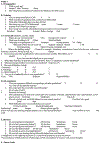Critical Care Medicine Practice: A Pilot Survey of US Anesthesia Critical Care Medicine-Trained Physicians
- PMID: 32665465
- PMCID: PMC8074021
- DOI: 10.1213/ANE.0000000000005030
Critical Care Medicine Practice: A Pilot Survey of US Anesthesia Critical Care Medicine-Trained Physicians
Abstract
Background: This survey assessed satisfaction with the practice environment among physicians who have completed fellowship training in critical care medicine (CCM) as recognized by the American Board of Anesthesiology (and are members of the American Society of Anesthesiology) and evaluated the perceived effectiveness of training programs in preparing fellows for critical care practice.
Methods: A cross-sectional online survey composed of 39 multiple choice and open-ended questions was administered between August and December 2018 to all members of the American Society of Anesthesiologists (ASA) who self-identified as being CCM trained. The survey instrument was developed and revised in an iterative fashion by ASA committee on CCM and the Society for Education in Anesthesia (SEA). Survey results were analyzed using a mixed-method approach.
Results: Three hundred fifty-three of the 1400 anesthesiologists who self-identified to the ASA as having CCM training (25.2%) completed the survey. Most were men (72.3%), board certified in CCM (98.7%), and had practiced a median of 5 years. Half of the respondents rated their training as "excellent." A total of 70.6% described currently working in academic centers with 53.6% providing care in open surgical intensive care units (ICUs). Most anesthesiologist intensivists (75%) spend at least 25% of their clinical time providing ICU care (versus clinical anesthesia). A total of 89% of the respondents were involved in educational activities, 60% reported being in administrative leadership roles, and 37% engaged in scholarly activity. Areas of dissatisfaction included fatigue, lack of collegiality or respect, lack of research training, decreased job satisfaction, and burnout. Analysis suggested moderate levels of job satisfaction (49%), work-life balance (52%), and high levels of burnout (74%). A significant contributor to burnout was with a perception of lack of respect (P = .005) in the work environment. Burnout was not significantly associated with gender or duration of practice. Qualitative analysis of the open-ended responses also identified these 3 variables as major themes.
Conclusions: This survey of CCM-trained anesthesiologists described a high rate of board certification, practice in academic settings, and participation in resident education. Areas of dissatisfaction with an anesthesia/critical care practice included burnout, work/life balance, and lack of respect. These results may increase recruitment of anesthesiologists into critical care and inform strategies to improve satisfaction with anesthesia critical care practice, fellowship training.
Copyright © 2020 International Anesthesia Research Society.
Conflict of interest statement
Conflicts of Interest: See Disclosures at the end of the article.
Figures
References
-
- Gasperino J The Leapfrog initiative for intensive care unit physician staffing and its impact on intensive care unit performance: A narrative review. Health Policy (New York). 2011;102(2-3):223–228. - PubMed
-
- Angus DC, Kelley MA, Schmitz RJ, White A, Popovich J, Committee on Manpower for Pulmonary and Critical Care Societies (COMPACCS). Caring for the critically ill patient. Current and projected workforce requirements for care of the critically ill and patients with pulmonary disease: can we meet the requirements of an aging population? JAMA. 2000;284(21):2762–2770. http://www.ncbi.nlm.nih.gov/pubmed/11105183. Accessed April 15, 2019. - PubMed
-
- Durbin C, McLafferty C. Attitudes of anesthesiology residents toward critical care medicine training. Anesth Analg. 1993. September;77(3):418–26. - PubMed
Publication types
MeSH terms
Grants and funding
LinkOut - more resources
Full Text Sources
Medical




